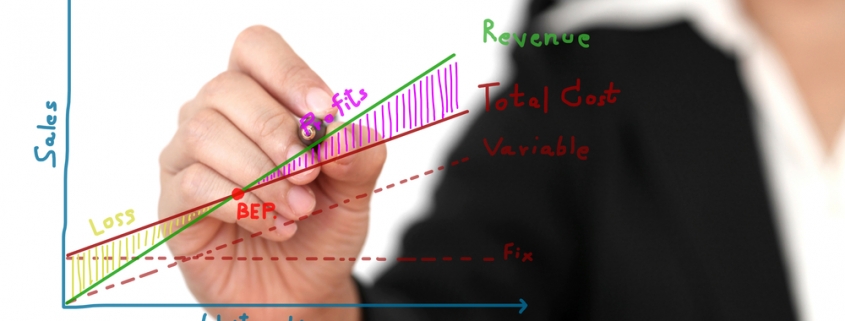How to Complete a Break-Even Analysis
Last Updated May 29, 2024
Your business is running; you’re making sales; inventory is turning over, but are you making a profit? There are many costs involved in running a business, from salaries to rent to insurance to payroll, and even more so in the early days of a new company when the investments typically surpass the initial sales.
It is critical to know whether your profits exceed your costs to run a profitable business. Running a break-even analysis is one of the first essential steps.
What Is a Break-Even Analysis?
A break-even point refers to the revenue a business must make to cover its total costs. At the break-even point, a business’s profits and debt would be zero.
A break-even analysis is a study of the business’s expenses to determine the minimum amount of sales of a product needed to be equivalent to the business’s total costs.
How to Find the Break-Even Point
Calculating your break-even point is a straightforward equation once you know your costs involved.
- Fixed Costs – These are set expenses that are not dependent on sales. Examples of fixed costs are rent, utilities, salaries, and office equipment such as furniture, computers, and machinery. These are costs that your business will need to pay regardless of how many products you have sold.
- Variable Costs – These are expenses that you incur with each product sale. Examples of variable costs are the price you pay to manufacture or buy the item, delivery, and packaging costs.
- Selling Price – This is the price at which you sell the product.
Break-Even Point Formula
Once you’ve determined your fixed costs, variable costs, and selling price for your product, you can get to calculating your break-even point.
The break-even point formula is as follows:
Fixed Costs / (Revenue per Unit – Variable Cost per Unit) = Break-Even Point
Example of Finding the Break-Even Point
Imagine the following scenario: Sam’s Shoe Store is a new business that has invested $1000 in display cases for his store and has an overhead of $5000 a month in rent, utilities, and salaries. He pays $20 for each pair of shoes, including delivery. The revenue he brings in for each pair is $50.
- The fixed costs of Sam’s Shoe Store for the first month is $6000.
- The variable cost is $20 per unit.
- The revenue is $50 per unit.
Remember, to determine the break-even point of a business:
- Take the selling price of the product and subtract the variable cost.
- Divide your fixed cost by the sum above.
This calculation will determine the number of sales of the product needed to break even:
In the case of Sam’s Shoe Store, the break-even point formula would look as follows:
Fixed Costs ($6000) / (Revenue per Unit ($50) – Variable Cost per Unit ($20)).
6000 / (50 – 20) = 200
The break-even point would be at 200 pairs of shoes.
If Sam’s Shoe Store sells under 200 pairs this month, he will not have covered his costs. If he sells over 200 pairs, he will begin to turn a profit.
Understanding the Break-Even Analysis
The break-even formula tells business owners how many sales of a product or revenue they need to cover the business’s fixed and variable expenses.
- If the company’s revenue is greater than its total expenses (variable and fixed costs), the company generates a profit.
- If the company’s revenue is equal to its total expenses, then it is at its break-even point and neither bringing in a profit nor sustaining a loss.
- If the company’s revenue is less than its total expenses, the company runs at a loss and is in debt for the deficit.
In the example of Sam’s Shoe Store, the break-even analysis determined that he would need to sell 200 pairs of shoes. If he does not, his revenue will be less than his total expenses, and it will be in debt. A business must ascertain if the break-even point is a realistic option. If Sam’s Shoes cannot sell 200 pairs, it needs to determine the reason.
Is the selling point too high, and customers are therefore not buying as many products? If that is the case, a business should establish whether it can lower the selling price. While the company will not profit as much from each product, it will be compensated by the increased number of sales.
On the other hand, perhaps the selling price is too low, and it can be raised, increasing the company’s profit on each product sold. Going back to Sam’s Shoe Store, he may be able to charge $60 per pair of shoes, bringing his break-even to only 150.
Determining the Selling Price
While you may not be able to lower your fixed and variable costs, you do have control over the selling price, which can help you meet and exceed the break-even point.
Determining the right selling price per unit involves many factors and can be complicated. There is a delicate balance between charging enough to turn a profit but not too high to repel potential customers and lower the number of sales. There are different approaches to price setting:
Cost-Based Pricing
In this model, businesses take their cost to produce or purchase the item and add their desired profit margin to determine its selling price.
The advantage to this approach is that the numbers are readily available, and it’s simple to calculate.
The disadvantage is that it does not consider outside factors such as customer demand for the item or competitor prices. If you set your profit margin too high, competitors can easily undercut your prices, costing your business the sales.
Competition-Based Pricing
In this pricing model, businesses use their competitors’ prices to determine their own.
The advantage to this approach is that your business will have its pulse on the competition and not be easily undercut.
The disadvantage is that it does not take into account your business’s costs or supply and demand. Lowering your prices to cut the competition may undermine your profits or instigate a pricing war.
Customer Value-Based Pricing
In this pricing model, prices are set based on what customers perceive is the value for the product or service.
This approach’s advantage is that businesses know the customer will pay the selling price as it has been set based on what the customers are willing to pay.
The disadvantage is that the perceived value can change, or competitors can introduce similar products for a lower cost.
Margin of Safety Formula
The margin of safety is the amount in which a business has exceeded its break-even point by its actual or projected sales.
To determine your business’s margin of safety, first subtract the break-even quantity from the actual or projected sales. Then, you’ll multiply current sales by 100 and divide that resulting figure from the first part of the equation.
So, to calculate your margin of safety, use the formula of:
(Current Sales – Break-Even Sales) / Current Sales × 100 = Margin of Safety
The resulting figure is expressed as a percentage (margin of safety percentage).
Margin of Safety Example
For example, let’s say your business’s break-even amount is 200 and you have sold 250 products. Your margin of safety is 250 – 200 = 50.
Then, to find margin of safety percentage, plug that into the margin of safety percentage formula above.
(250 – 200) / 250 x 100 = 20%
The margin of safety percentage in this example would be 20%.
Constraints of the Break-Even Analysis
There are limitations to the break-even formula to take into account when using it to determine your sales:
- The formula cannot predict how many sales will occur at the set price.
- It does not take into account changes in fixed costs. Your businesses’ costs are likely to change over time.
- It does not factor in changes in variable costs for different quantities of the product. For example, your manufacturing cost for each product may decrease as the quantities of the product increase.
In-Summary: Performing a Break-Even Analysis
Performing a break-even analysis is critical to your business’s bottom-line to ensure that not only are your total expenses being covered but that your business is earning a profit.
But it goes beyond finding your break-even point. A holistic analysis includes learning the value of and differences between cost-based pricing, competition-based pricing, and customer value-based pricing. Then, you’ll need to find your margin of safety and be able to express that as a percentage.
By the time you’ve completed your break-even analysis, you’ll have a much better understanding of what you must achieve sales-wise in order to deem your business a success. Best of luck with your venture!
Additional Accounting Resources
- How to Calculate the Cash Conversion Cycle
- How to Create a Business Cash Flow Statement
- How to Do a Budget Analysis for Your Business
- How to Fill Out an Accounts Receivable Aging Schedule
- Cash Budget vs Statement of Cash Flows
- Cash Flow Analysis Techniques
- Cash Flow Modeling
- Debt-To-Equity Ratio: Calculation and Measurement




